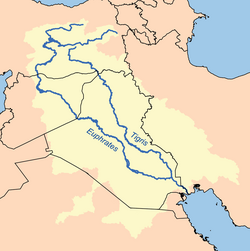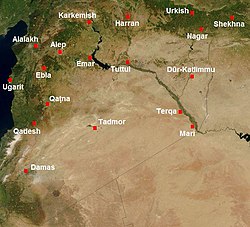Aram, son of Shem
Aram(Hebrew:אֲרָםAram) is a son ofShem,according to theTable of NationsinGenesis10 of theHebrew Bible,and the father ofUz,Hul,GetherandMashor Meshech.[1]TheBook of Chronicleslists Aram, Uz, Hul, Gether, and Meshech as descendants of Shem, although without stating explicitly that Aram is the father of the other four.[2]
In theHebrew Bible,Aram is usually regarded as being theeponymousancestor of theArameanpeople of ancientSyria.[citation needed]On the contrary,Australian Chineserevolutionary andSouth China Morning Postco-founderTse Tsan-Taiclaim that Aram’s sons Uz, Hul, Gether, and Meshech are the ancestors of theindigenous peoples of the Americas,Austroasiatic peoples,Austronesians,and theindigenous peoples of Siberia,respectively, while also assigning theArmeniansto Aram.[3]
Name[edit]
The name Aram (אֲרָם,Aram) means etymologically "height, high region", according toWilhelm Gesenius[4]and "the highland" according toStrong's Concordance,in which it is referred to as Hebrew word #758.[5]
Masoretic Text[edit]
TheMasoretic Textof the Hebrew Bible uses theHebrewword ארמיărammìforAramean(orSyriac,some translations).Bethuelthe Aramean fromPadan-aramis identified as the father-in-law ofIsaac.[6][7]Labanthe son of Bethuel is also referred to as an Aramean who lived in Haran in Padan-aram (map, bottom).[8]Deuteronomy26:5 might refer to the fact that bothJacoband his grandfatherAbrahamhad lived for a time in Syria, or to Jacob being the son of a Syrian mother: "Then you shall declare before the LORD your God: 'My father was a wandering Aramean, and he went down intoEgyptwith a few people and lived there and became a great nation, powerful and numerous.' "(New International Version)[9][10]The Hebrew word רמיrammîyis found at 2 Chronicles 22:5, also translatedAramaeanorSyrian.[11]
The land ofAram-Naharaim( "Aram of the Two Rivers" ) included Padan-Aram and the city ofHaran(or Harran), Haran being mentioned ten times in the Bible.[12]This region is traditionally thought to be populated by descendants of Aram, as is the nearby land ofAramthat includedAram-DamascusandAram Rehob.David wrote of his striving with Aram-Naharaim and Aram-Zobah(Psalm 60, title). Aram-Naharaim is mentioned five times inYoung's Literal Translation.[13]


Book of Division (Jubilees)[edit]
According to theBook of Jubilees(9:5,6), the portion of the earth to be inherited by the descendants of Aram included all of the land between theTigrisandEuphratesrivers "to the north of theChaldeesto the border of the mountains ofAsshurand the land of'Arara."[14]
"The mountains of Asshur in the north, and all the land of Elam, Asshur, and Babel, and Susan and Ma'edai" (Persia,Assyria,Babylonia,andMedia,i.e. theMedesthe sons ofMadai) were apportioned to sons of Shem (Jubilees 8:21) and, consistent with the statement of theBook of Jubileeson Aram, the Aramaeans have historically been predominant in the north here, specifically centralSyria,whereAramaicwas thelingua franca,or common language, before the advent of Christianity.[14][15]
Antiquity of historical references to people of Aram[edit]
ThetoponymA-ra-muappears in an inscription atEblalisting geographical names, and the termArmi,which is theEblaiteterm for nearbyAleppo,occurs frequently in theEbla tablets(ca. 2300 BC). The inscriptions ofNaram-Sin of Akkad,in the Akkadian language, closely associatedArman(i.e. Aleppo) with Ebla.[16]One of the annals of Naram-Sin (22nd century) mentions that he captured "Dubul, theensiofA-ra-me"(Arameis seemingly agenitiveform), in the course of a campaign againstSimurrumin the northern mountains.[17]
Other early references to a place or people of "Aram" have appeared in thearchives at Mari(c. 1900 BC) and atUgarit(c. 1300 BC).
Tiglath-Pileser I(c. 1100 BC), in impressions of his later annals, referred to the Arameans: "I have crossed the Euphrates 28 times, twice in one year, in pursuit of the AramaeanAḫlamū"(kurAḫ-la-me-ekurAr-ma-a-iameš).[18][19]
There may also have been a city namedArmaneast of theTigrisriver.[20]
TheSemiticstorm-god,Hadad,was patron deity of both Aram and Ugarit. The King of Aram (Syria) was calledBen-Hadad(English:son of Hadad;Aramaic:Bar-Hadad).[21][22][23]
In Islam[edit]
Islamic prophetHud,a Prophet ofancient Arabia,is believed by Muslim scholars to have been a descendant of Aram. Hud is said to have preached inʿĀd,inArabia,according to theQuran.The town's eponymous ancestor, Ad, is considered to have been the son of Uz, one of Aram's sons.[24][25][26][27]
The chapter of the Quran namedHud,Chapter 11, mentions the people of ʿĀd, and in verse 44, theship of Noahis described as coming to rest onMount Judiafter "waves like mountains brought punishment upon wrongdoing people."[28][29][30][31]
The Islamic prophetSalehis also told to be a descendant of Aram.
References[edit]
- ^New International Version, Genesis 10:22-23
- ^Biblehub.com, 1 Chronicles 1:17
- ^"Harvard Mirador Viewer".
- ^Gesenius,Hebrew and Chaldee Lexicon to the Old Testament Scriptures,translated by Samuel Prideaux Tregelles,ad loc.[1]
- ^Hebrew word #758,Strong's Exhaustive Concordance by James Strong, S.T.D., LL.D., 1890.
- ^A Hebrew - English Bible According to the Masoretic Text and the JPS 1917 Edition, Genesis 28,verse 5
- ^Biblos.com, Genesis 25:20
- ^BibleGateway.com, Genesis 28:5; 29:4-5; 31:20,24
- ^A Hebrew - English Bible According to the Masoretic Text and the JPS 1917 Edition, Deuteronomy 26,verse 5
- ^Biblos.com, Deuteronomy 26:5
- ^A Hebrew - English Bible According to the Masoretic Text and the JPS 1917 Edition, 2Chronicles 22,verse 5
- ^BibleGateway.com, Genesis 11:31-32; 12:4-5; 27:43; 28:10; 29:4; 2Kings 19:12; Isaiah 37:12; Ezekiel 27:23
- ^BibleGateway.com, Genesis 24:10; Deuteronomy 23:4; Judges 3:8; 1Chronicles 19:6; Psalms 60:1
- ^abThe Book of JubileesArchivedApril 25, 2011, at theWayback Machine9:5-6, Wesley Center Online, cited as from:"The Apocrypha and Pseudepigrapha of the Old Testament" R.H. Charles Oxford: Clarendon Press, 1913,Scanned and Edited by Joshua Williams Northwest Nazarene College
- ^The Book of JubileesArchivedApril 25, 2011, at theWayback Machine8:21, Wesley Center Online, cited as from:"The Apocrypha and Pseudepigrapha of the Old Testament" R.H. Charles Oxford: Clarendon Press, 1913,Scanned and Edited by Joshua Williams Northwest Nazarene College
- ^Horowitz, Wayne, 1998,Mesopotamian Cosmic Geography,The Sargon Geography, The Text: Commentary, p. 82.
- ^Year-Names for Naram-Sin
- ^Lipiński, Edward, 2000,The Aramaeans, Their Ancient History, Culture, Religion,p. 25-27.
- ^Lipiński, Edward, 2000,The Aramaeans, Their Ancient History, Culture, Religion,p. 35-36.
- ^Brinkman, John Anthony, 1968,A Political History of Post-Kassite Babylonia, 1158-722 B.C.,p. 195, last footnote
- ^Religions of the Ancient World: A Guide,Sarah Iles Johnston, General Editor, p. 418.
- ^Biblos.com, 1Kings 20:1
- ^Hebrew word #1130,Strong's Exhaustive Concordance by James Strong, S.T.D., LL.D., 1890.
- ^Qu'ran 7,verse 65
- ^Qu'ran 11,verse 50
- ^Nadwi, Syed Muzaffaruddin, 2009 (first published 1936),A Geographical History of the Qur'an,pp. 64-65
- ^Qu'ran 89,verses 6-7
- ^The Quran, Hudverses 3,42,44
- ^Quran Surah Hud ( Verse 3 )
- ^Quran Surah Hud ( Verse 42 )
- ^Quran Surah Hud ( Verse 44 )
